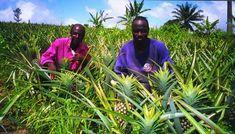
Ghana has long been dependent on a few export crops ñ such as cocoa, cotton and palm oil ñ which are extremely vulnerable to price fluctuations. In recent years, however, the Ghanaian government has focused its attention on diversifying the country's export base with the horticulture sector flagged as a sector with promising prospects.
As production is spread among many farms, producers are finding it difficult to guarantee quality, especially in light of changing EU regulations on food safety and traceability.
As far as vegetable production in Ghana is concerned, tomatoes lead the way with an estimated 200,000 tonnes a year. Chillies, onions, and okra account for about 150,000, 30,000, and 150,000t respectively. While the production of major starchy root crops, such as cassava (8.1 million tonnes), yams (3.36mt), taro (1.63mt), and plantain (1.93mt) has gained importance over the last few years, the bulk of these crops continues to be consumed locally.
Fruit production consists of pineapples (60,000t), oranges (300,000t), lemons (30,000t), bananas (10,000 to 15,000t), kola nuts (20,000t), mangoes (4,000t), and papaya (2,000t).
PINEAPPLES CROWN EXPORT LIST
In recent years, exports of horticulture products from Ghana have increased significantly. Although bananas, papayas, root crops (yams, cassava, etc.), and other vegetables such as okra and aubergines play an important role in the country's export potential to the EU, the main driver has been the pineapple.
Production of pineapples on an industrial scale began in the 1980s and by the end of the decade Ghana had become one of the most important suppliers of quality pineapples to Europe, mainly Belgium, Luxembourg, Italy, France and the UK. At the beginning of the 1980s most pineapple exports were air-freighted, but in the 1990s sea-freight was introduced with the help of international donors. This form of transport reduced exporting costs and consequently gave a growing number of producers access to international markets.
Exports of pineapples to Europe ñ the Smooth Cayenne variety for the most part ñ have increased nearly fourfold since 1995, but Ghana has had to contend with two powerful competitors, namely Costa Rica and the Côte d'Ivoire. Production of pineapples in these two countries is usually conducted on large farms or plantations, which enjoy economies of scale and easily controlled growing conditions. In Ghana, on the other hand, the production of pineapples ñ and the horticulture industry in general ñ is mostly made up of many producers and exporters who rely to varying degrees on outñgrowers.
About a third of pineapple production in Ghana comes from outgrowers, most of which work on small plots of land spanning less than 10 acres. Relying on such small growers reduces the incidence of economies of scale. It also poses problems of management, quality control, and consistency for producers, which, like Farmapine Ghana Limited, depend on outñgrowers for a part of their supply of fresh pineapples. “Farmapine works with a huge number of farmers, about 300,” explains Albert Datsa, the company's export manager, “and as fruits come from many farms, guaranteeing quality is difficult. Traceability and data management are also difficult, especially because many outñgrowers are illiterate.” Faced with such challenges, producers are concerned that complying with increasingly stringent EU regulations on food safety and traceability will be a formidable task. Ghanaian producers and exporters therefore need a helping hand to prepare their staff to meet EU regulatory requirements and European market pressures.
FULFILING NEEDS OF AN INDUSTRY
A number of initiatives have been launched at national level to fulfil the training needs of the horticulture industry. But despite such initiatives ñ some of which have received assistance from international donors ñ producers in the industry maintain that local capacity remains insufficient to meet their needs. In an attempt to meet such needs the EU-funded Pesticides Initiative Programme (PIP) is helping the industry in a number of areas.
“In addition to direct support to individual export companies, another important aspect of our intervention in Ghana is the capacity-building work we're doing,” says Morag Webb, a PIP expert. “As there are also limitations in terms of post-harvest quality control and residue analysis capacity in the country, we train staff up to the required level to obtain accreditation.”
The remit of PIP, which was created in 2001, is to help fruit and vegetable growers from African, Caribbean and Pacific countries (ACP countries) adapt their production in compliance with EU food safety regulations. To this end it helps these companies identify practical problems, advises them on getting their crops to comply with European pesticide regulations and assists their staff in acquiring the appropriate food safety and traceability training. PIP also provides support to auxiliary structures, such as professional organisations and service providers ñ private or public ñ by helping them to reinforce their capacity in extending support services to producers and exporters within the horticulture sector.
Twelve Ghanaian producers and exporters of fruit and vegetables, professional organisations and service providers have applied for support from PIP and 10 of these have signed a protocol with Coleacp, the ACP-EU professional trade association in charge of implementing the programme. Exports of the companies that have applied for support concern mainly pineapples, papaya, okra, and yam. They amount to about 15,200t a year and represent the output of some 364 producers. The protocols cover a number of areas, namely audits, training of middle management, implementation of traceability and food safety systems, and certification with quality standards and benchmarks.



